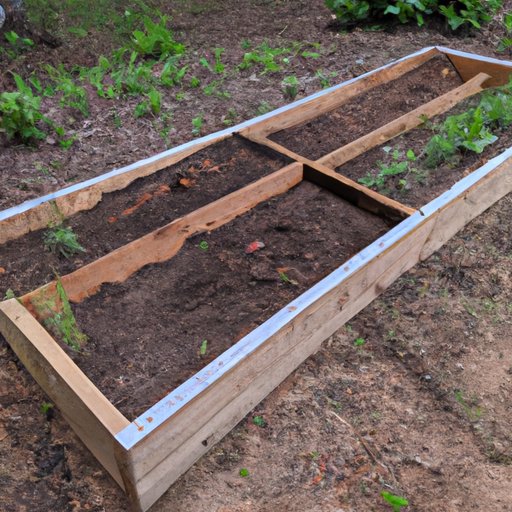
I. Introduction
Creating a raised garden bed might seem like an intimidating project, but it’s much easier than you might think. Not only does it provide a beautiful addition to your landscape, but it also protects your plants from pests and makes planting and harvesting much easier. This article will guide you through the process step-by-step and provide you with different design ideas, materials, and suggestions to fit your specific needs and budget.
II. Step-by-Step Guide
A step-by-step guide is an excellent way to navigate through the entire process of making a raised garden bed. Here’s a step-by-step guide that includes everything from beginning to end:
A. Choosing a Location
Start by choosing the right location for your raised garden bed. Select an area that receives at least 6 hours of sunlight daily, receives an adequate amount of water, and provides well-drained soil that’s rich in nutrients.
B. Measuring and Marking the Area
Once you have selected the location for your garden bed, measure and mark the area using stakes and twine. If you want straight lines, use a level and square to maintain accuracy. If you prefer a more organic feel, create a curvy border.
C. Preparing the Ground
The next step is to cultivate the soil and remove any unwanted grass, weeds, or rocks. If the area is covered with grass, you can use a garden spade to cut the turf and roll it back. Then, loosen the soil and add organic matter like compost. Using landscape fabric underneath the raised bed keeps weeds from growing up through the frame.
D. Building the Frame
After preparing the ground, it’s time to build the frame of your raised garden bed. Use pressure-treated lumber because it’s durable against the elements and won’t rot. Some people opt to purchase pre-made kits or use recycled material like cinder blocks or brick. Cut and assemble your lumber pieces with galvanized screws, keeping them in place with corner brackets and stakes. Adjust the height and dimensions to your desired size.
E. Filling the Bed with Soil
Finally, fill the bed with soil and prepare it for planting. Purchase soil that is specifically formulated for raised beds, such as “garden soil” or “container mix,” which is lighter and better aerated than regular soil. A recommended combination is 60% topsoil, 30% compost, and 10% sand. Spread it evenly and add more if necessary.
III. Best Materials and Tools
Choosing the right tools and materials for your raised garden bed is essential to ensure its durability. Here’s a list of the best materials and tools to use:
- Pressure-treated lumber
- Galvanized screws
- Corner brackets and stakes
- Landscape fabric
- Topsoil, compost, and sand
- Garden gloves
- Shovel and spade
- Level and square
Each material and tool has its pros and cons. For example, if you want to reduce costs, recycled materials like cinder blocks, bricks, or rocks may work as a substitute for pressure-treated lumber. But keep in mind, these could require more work to assemble and maintain. It’s important to research the right materials and tools for your garden bed to tailor the project to your budget and needs.
IV. Creative Ideas for Garden Beds
There are different design ideas for raised garden beds to create a cohesive look for your garden and lawn. Here are a few of the best design ideas:
- Tiered garden beds
- Circular garden beds
- Rectangular garden beds
- Curved garden beds
- Garden beds with trellises
A typical garden bed is usually four feet wide, but you can adjust the width and length to your specific needs. Follow the previous steps to build the frame, and then get creative with shapes and sizes to complement your garden and landscape design. If you’re worried that your choices won’t mesh well together, consult a professional prior to construction.
V. Cost-Effective Raised Garden Bed
If you’re concerned about the cost of constructing a raised garden bed, consider these suggestions:
- Build a small garden bed
- Use recycled materials
- Build higher instead of wider
The cost of a raised garden bed varies based on the size, lumber used, soil choice, and bed layout. A typical bed of 4′ x 8′ x 6′ of depth costs around $200. If you’re looking to build a cheaper option, reused materials such as leftover wooden pallets or old media consoles could make do. You can save costs by nesting smaller sections or by using more affordable materials.
VI. How-to Videos
If you prefer to see the process in action visually, consider checking out the following how-to video to help you construct your raised garden bed:
How to Build a Raised Garden Bed: Planning, Building, and Planting | The Old Farmer’s Almanac
VII. Conclusion
Creating a raised garden bed is easier than you think by following the step-by-step guide provided above. It’s a great opportunity to improve the quality of your soil and enhance your garden’s overall design. With the tips on cost-effective and attractive design ideas, anyone could create the perfect garden bed that fits their unique needs and budget.




